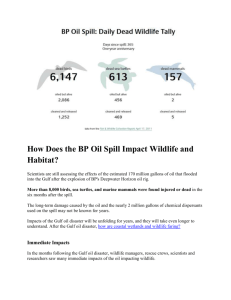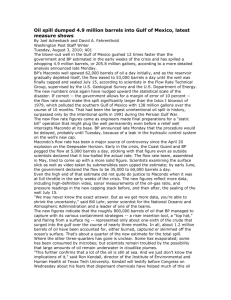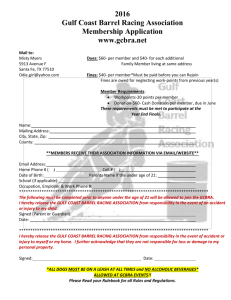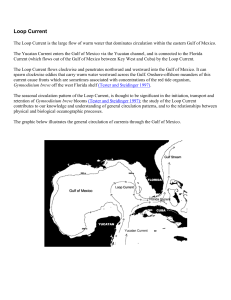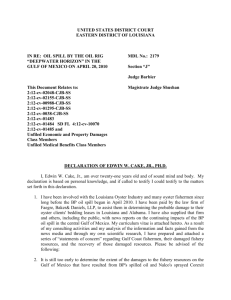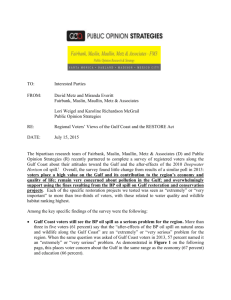File - Geog Rocks
advertisement
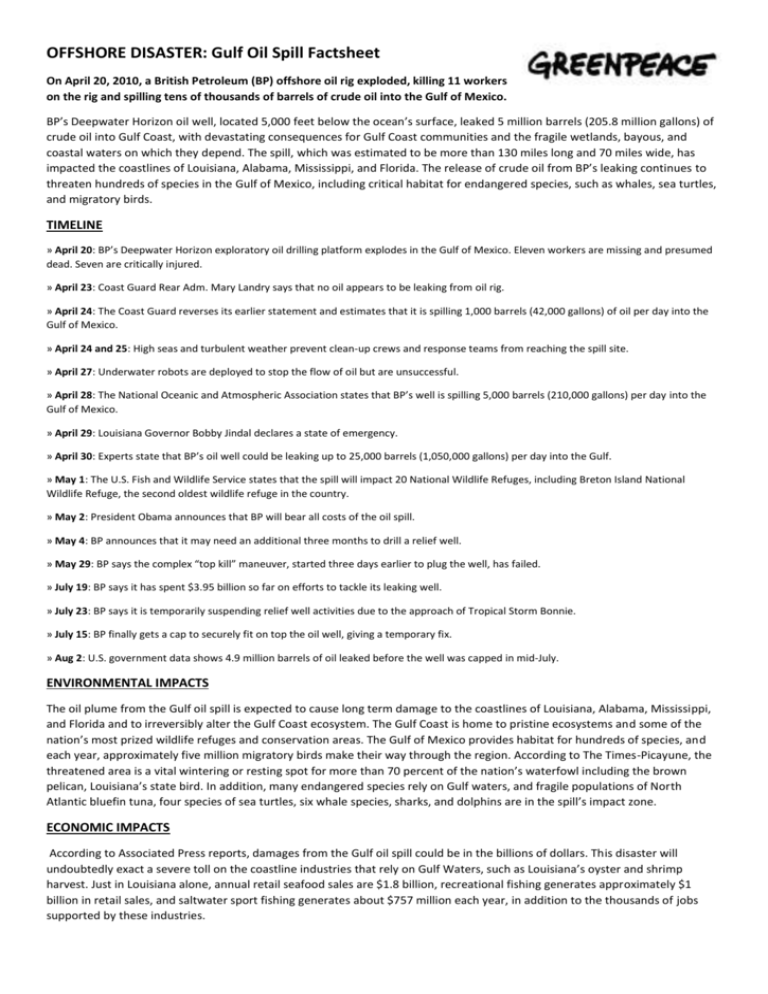
OFFSHORE DISASTER: Gulf Oil Spill Factsheet On April 20, 2010, a British Petroleum (BP) offshore oil rig exploded, killing 11 workers on the rig and spilling tens of thousands of barrels of crude oil into the Gulf of Mexico. BP’s Deepwater Horizon oil well, located 5,000 feet below the ocean’s surface, leaked 5 million barrels (205.8 million gallons) of crude oil into Gulf Coast, with devastating consequences for Gulf Coast communities and the fragile wetlands, bayous, and coastal waters on which they depend. The spill, which was estimated to be more than 130 miles long and 70 miles wide, has impacted the coastlines of Louisiana, Alabama, Mississippi, and Florida. The release of crude oil from BP’s leaking continues to threaten hundreds of species in the Gulf of Mexico, including critical habitat for endangered species, such as whales, sea turtles, and migratory birds. TIMELINE » April 20: BP’s Deepwater Horizon exploratory oil drilling platform explodes in the Gulf of Mexico. Eleven workers are missing and presumed dead. Seven are critically injured. » April 23: Coast Guard Rear Adm. Mary Landry says that no oil appears to be leaking from oil rig. » April 24: The Coast Guard reverses its earlier statement and estimates that it is spilling 1,000 barrels (42,000 gallons) of oil per day into the Gulf of Mexico. » April 24 and 25: High seas and turbulent weather prevent clean-up crews and response teams from reaching the spill site. » April 27: Underwater robots are deployed to stop the flow of oil but are unsuccessful. » April 28: The National Oceanic and Atmospheric Association states that BP’s well is spilling 5,000 barrels (210,000 gallons) per day into the Gulf of Mexico. » April 29: Louisiana Governor Bobby Jindal declares a state of emergency. » April 30: Experts state that BP’s oil well could be leaking up to 25,000 barrels (1,050,000 gallons) per day into the Gulf. » May 1: The U.S. Fish and Wildlife Service states that the spill will impact 20 National Wildlife Refuges, including Breton Island National Wildlife Refuge, the second oldest wildlife refuge in the country. » May 2: President Obama announces that BP will bear all costs of the oil spill. » May 4: BP announces that it may need an additional three months to drill a relief well. » May 29: BP says the complex “top kill” maneuver, started three days earlier to plug the well, has failed. » July 19: BP says it has spent $3.95 billion so far on efforts to tackle its leaking well. » July 23: BP says it is temporarily suspending relief well activities due to the approach of Tropical Storm Bonnie. » July 15: BP finally gets a cap to securely fit on top the oil well, giving a temporary fix. » Aug 2: U.S. government data shows 4.9 million barrels of oil leaked before the well was capped in mid-July. ENVIRONMENTAL IMPACTS The oil plume from the Gulf oil spill is expected to cause long term damage to the coastlines of Louisiana, Alabama, Mississippi, and Florida and to irreversibly alter the Gulf Coast ecosystem. The Gulf Coast is home to pristine ecosystems and some of the nation’s most prized wildlife refuges and conservation areas. The Gulf of Mexico provides habitat for hundreds of species, and each year, approximately five million migratory birds make their way through the region. According to The Times-Picayune, the threatened area is a vital wintering or resting spot for more than 70 percent of the nation’s waterfowl including the brown pelican, Louisiana’s state bird. In addition, many endangered species rely on Gulf waters, and fragile populations of North Atlantic bluefin tuna, four species of sea turtles, six whale species, sharks, and dolphins are in the spill’s impact zone. ECONOMIC IMPACTS According to Associated Press reports, damages from the Gulf oil spill could be in the billions of dollars. This disaster will undoubtedly exact a severe toll on the coastline industries that rely on Gulf Waters, such as Louisiana’s oyster and shrimp harvest. Just in Louisiana alone, annual retail seafood sales are $1.8 billion, recreational fishing generates approximately $1 billion in retail sales, and saltwater sport fishing generates about $757 million each year, in addition to the thousands of jobs supported by these industries.



